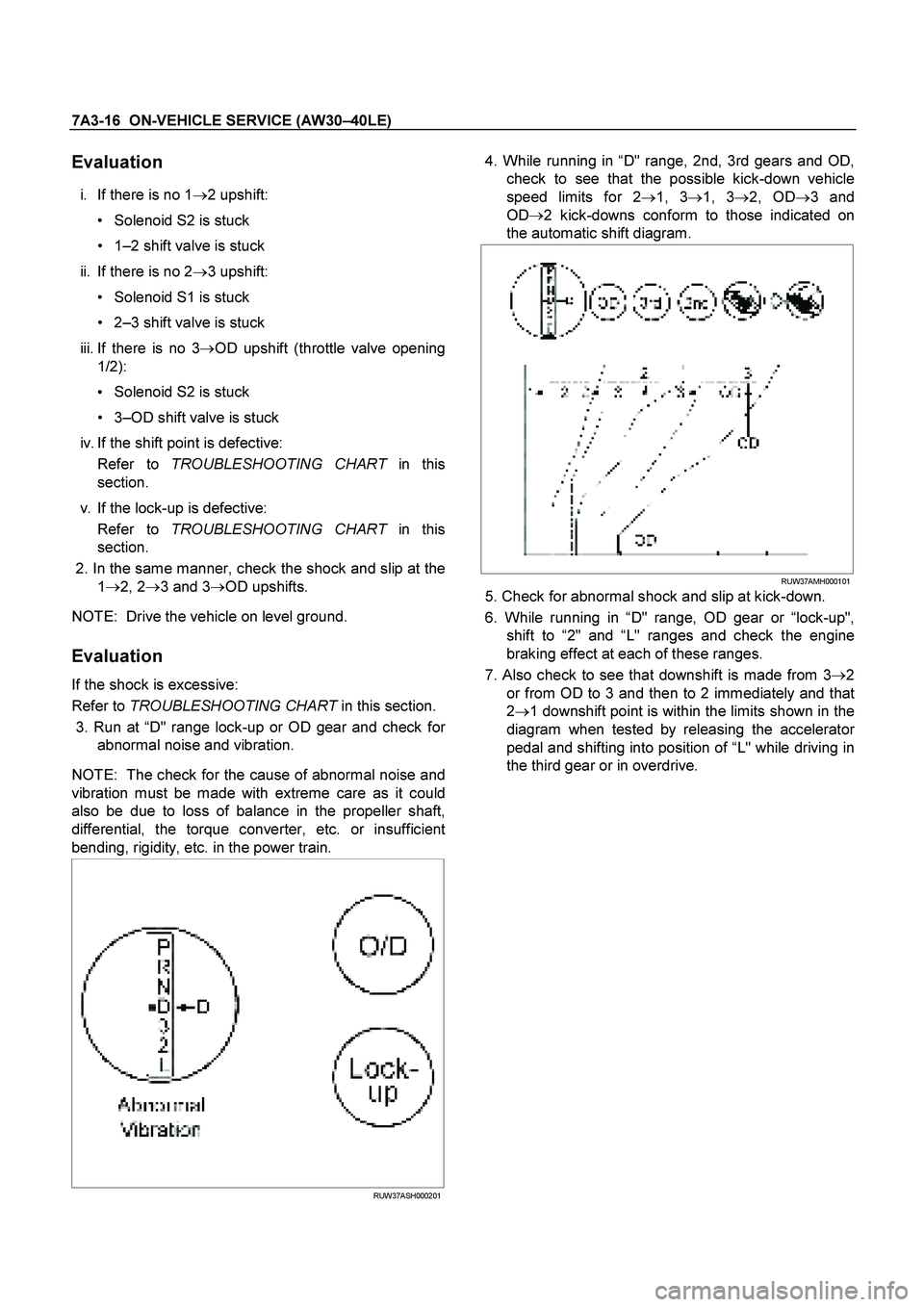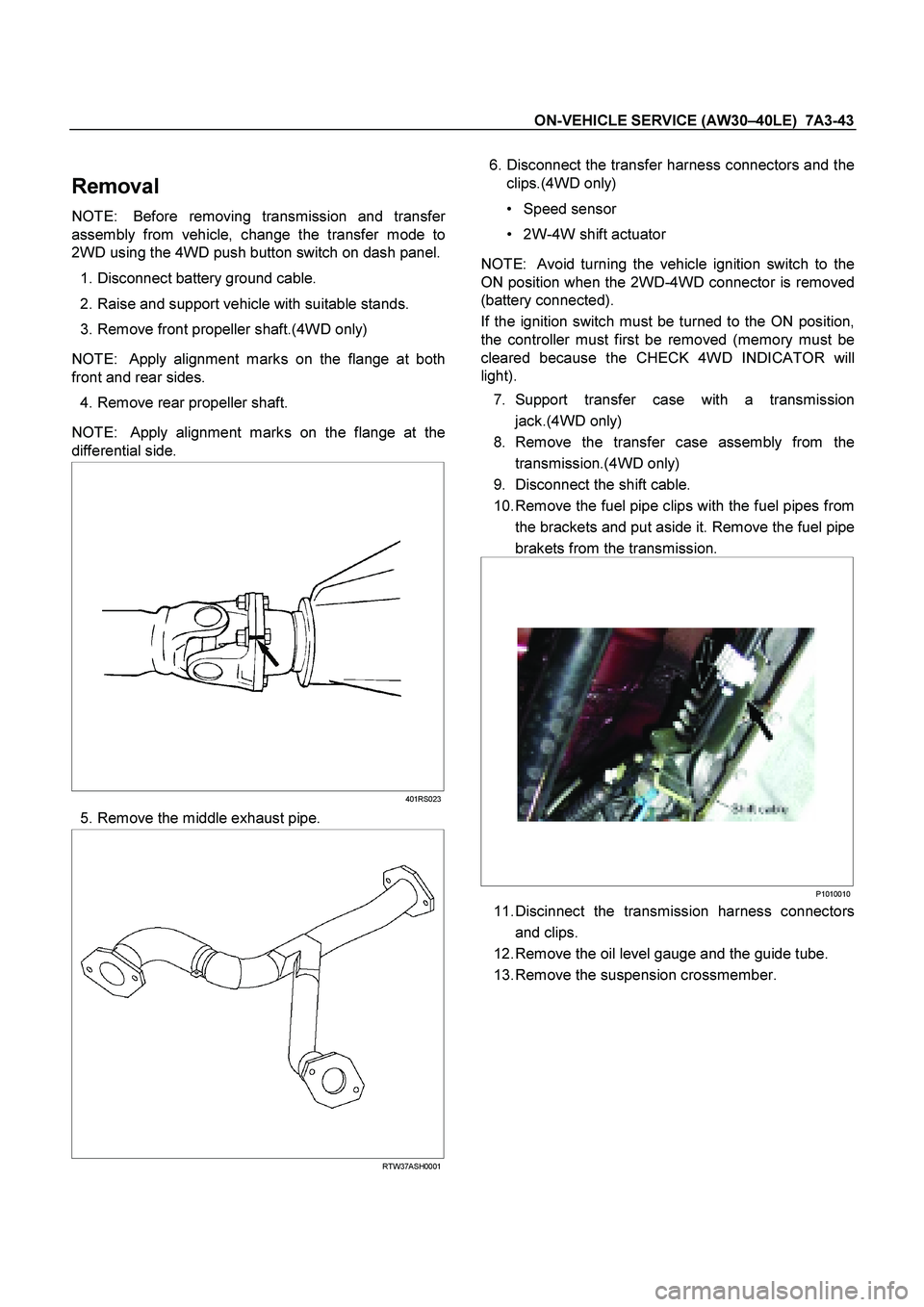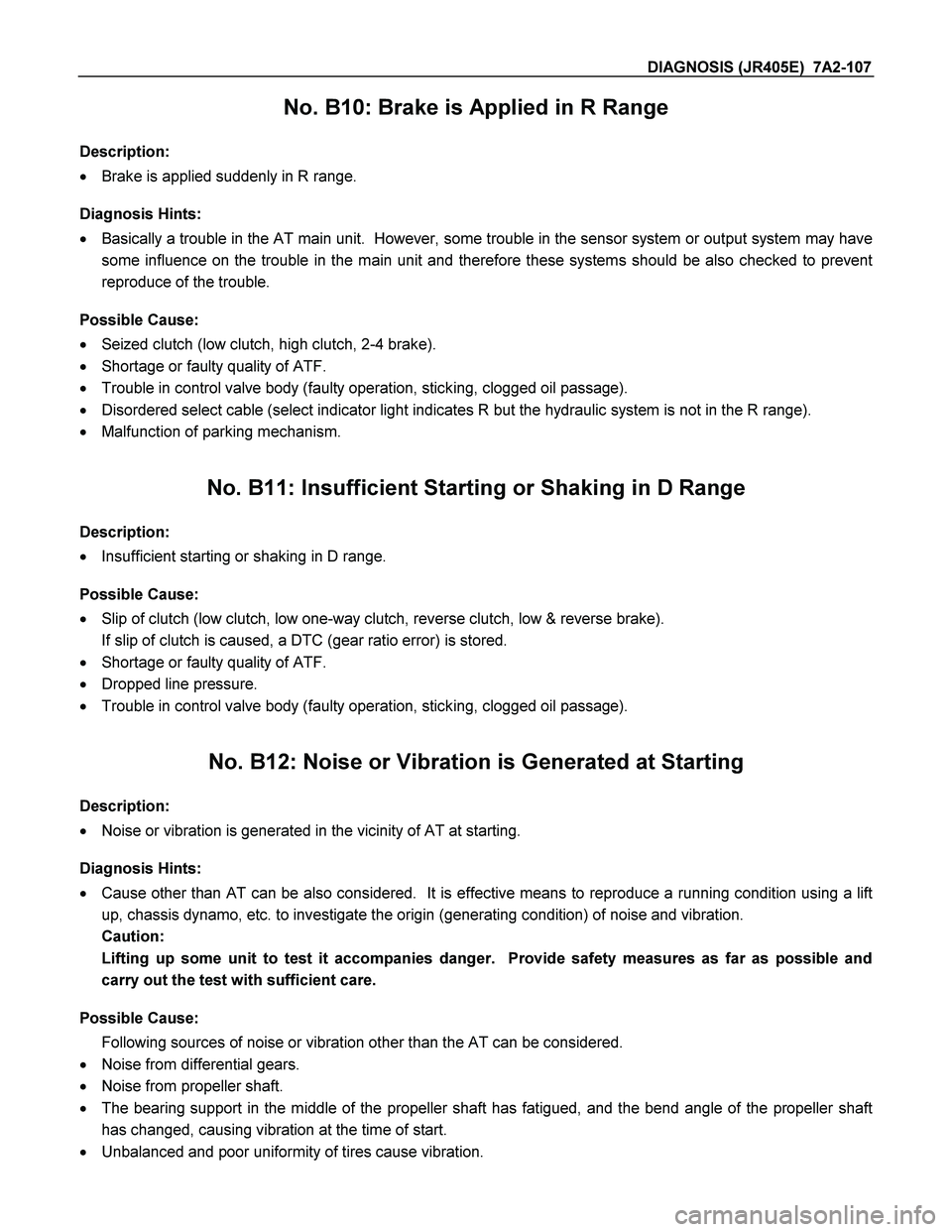Page 3772 of 4264

7A3-16 ON-VEHICLE SERVICE (AW30 –40LE)
Evaluation
i. If there is no 1 �
2 upshift:
Solenoid S2 is stuck
1 –2 shift valve is stuck
ii. If there is no 2 �
3 upshift:
Solenoid S1 is stuck
2 –3 shift valve is stuck
iii. If there is no 3 �
OD upshift (throttle valve opening
1/2):
Solenoid S2 is stuck
3 –OD shift valve is stuck
iv. If the shift point is defective: Refer to TROUBLESHOOTING CHART in this
section.
v. If the lock-up is defective: Refer to TROUBLESHOOTING CHART in this
section.
2. In the same manner, check the shock and slip at the 1 �
2, 2 �
3 and 3 �
OD upshifts.
NOTE: Drive the vehicle on level ground.
Evaluation
If the shock is excessive:
Refer to TROUBLESHOOTING CHART in this section.
3. Run at “D" range lock-up or OD gear and check fo
r
abnormal noise and vibration.
NOTE: The check for the cause of abnormal noise and
vibration must be made with extreme care as it could
also be due to loss of balance in the propeller shaft,
differential, the torque converter, etc. or insufficient
bending, rigidity, etc. in the power train.
RUW37ASH000201
4. While running in “D" range, 2nd, 3rd gears and OD,
check to see that the possible kick-down vehicle
speed limits for 2 �1, 3 �1, 3 �2, OD �3 and
OD �
2 kick-downs conform to those indicated on
the automatic shift diagram.
RUW37AMH000101
5. Check for abnormal shock and slip at kick-down.
6. While running in “D" range, OD gear or “lock-up",
shift to “2" and “L" ranges and check the engine
braking effect at each of these ranges.
7. Also check to see that downshift is made from 3 �
2
or from OD to 3 and then to 2 immediately and that
2 �
1 downshift point is within the limits shown in the
diagram when tested by releasing the accelerato
r
pedal and shifting into position of “L" while driving in
the third gear or in overdrive.
Page 3799 of 4264

ON-VEHICLE SERVICE (AW30 –40LE) 7A3-43
Removal
NOTE: Before removing transmission and transfer
assembly from vehicle, change the transfer mode to
2WD using the 4WD push button switch on dash panel.
1. Disconnect battery ground cable.
2. Raise and support vehicle with suitable stands.
3. Remove front propeller shaft.(4WD only)
NOTE: Apply alignment marks on the flange at both
front and rear sides.
4. Remove rear propeller shaft.
NOTE: Apply alignment marks on the flange at the
differential side.
401RS023
5. Remove the middle exhaust pipe.
RTW37ASH0001
6. Disconnect the transfer harness connectors and the
clips.(4WD only)
Speed sensor
2W-4W shift actuator
NOTE: Avoid turning the vehicle ignition switch to the
ON position when the 2WD-4WD connector is removed
(battery connected).
If the ignition switch must be turned to the ON position,
the controller must first be removed (memory must be
cleared because the CHECK 4WD INDICATOR will
light).
7. Support transfer case with a transmission jack.(4WD only)
8. Remove the transfer case assembly from the
transmission.(4WD only)
9. Disconnect the shift cable.
10. Remove the fuel pipe clips with the fuel pipes from the brackets and put aside it. Remove the fuel pipe
brakets from the transmission.
P1010010
11. Discinnect the transmission harness connectors
and clips.
12. Remove the oil level gauge and the guide tube.
13. Remove the suspension crossmember.
Page 4099 of 4264

DIAGNOSIS (JR405E) 7A2-107
No. B10: Brake is Applied in R Range
Description:
� Brake is applied suddenly in R range.
Diagnosis Hints:
� Basically a trouble in the AT main unit. However, some trouble in the sensor system or output system may have
some influence on the trouble in the main unit and therefore these systems should be also checked to prevent
reproduce of the trouble.
Possible Cause:
� Seized clutch (low clutch, high clutch, 2-4 brake).
� Shortage or faulty quality of ATF.
� Trouble in control valve body (faulty operation, sticking, clogged oil passage).
� Disordered select cable (select indicator light indicates R but the hydraulic system is not in the R range).
� Malfunction of parking mechanism.
No. B11: Insufficient Starting or Shaking in D Range
Description:
� Insufficient starting or shaking in D range.
Possible Cause:
� Slip of clutch (low clutch, low one-way clutch, reverse clutch, low & reverse brake).
If slip of clutch is caused, a DTC (gear ratio error) is stored.
� Shortage or faulty quality of ATF.
� Dropped line pressure.
� Trouble in control valve body (faulty operation, sticking, clogged oil passage).
No. B12: Noise or Vibration is Generated at Starting
Description:
� Noise or vibration is generated in the vicinity of AT at starting.
Diagnosis Hints:
� Cause other than AT can be also considered. It is effective means to reproduce a running condition using a lift
up, chassis dynamo, etc. to investigate the origin (generating condition) of noise and vibration.
Caution:
Lifting up some unit to test it accompanies danger. Provide safety measures as far as possible and
carry out the test with sufficient care.
Possible Cause:
Following sources of noise or vibration other than the AT can be considered.
� Noise from differential gears.
� Noise from propeller shaft.
� The bearing support in the middle of the propeller shaft has fatigued, and the bend angle of the propeller shaft
has changed, causing vibration at the time of start.
� Unbalanced and poor uniformity of tires cause vibration.
Page 4122 of 4264

7A2-130 DIAGNOSIS (JR405E)
No. F2: Engine Races Up During Acceleration (Slip)
Description:
� The engine speed up when the accelerator pedal is stepped on for acceleration and the gear is shifted up or
down.
� Only the engine speeds up but vehicle speed does not increase when the accelerator pedal is stepped on for
acceleration during the running.
Diagnosis Hints:
� Basically same causes as "No. C1 - C8: Engine races up (slip) by shift up or shift down" are considered.
When the condition of No. C1-C8 grows worse, symptom of No. F2 results.
No. F3: Noise or Vibration During the Running in R, D, 3, 2 or L Range
Description:
� Noise or vibration is generated in the vicinity of AT during the running.
Diagnosis Hints:
� Cause other than AT can be also considered. It is effective means to reproduce a running condition using a lift
up, chassis dynamo, etc. to investigate the origin (generating condition) of noise and vibration.
Caution:
Lifting up some unit to test it accompanies danger. Provide safety measures as far as possible and
carry out the test with sufficient care.
Possible Cause:
Following sources of noise or vibration other than the AT can be considered.
� Noise from differential gears.
� Noise from propeller shaft.
� The bearing support in the middle of the propeller shaft has fatigued, and the bend angle of the propeller shaft
has changed, causing vibration at the time of start.
� Unbalanced and poor uniformity of tires cause vibration.
No. F4: Engine Brake Does Not Apply in L Range
Description:
� The engine brake does not apply, allowing the vehicle to run freely when the accelerator pedal is released at low
speed in L range.
Possible Cause:
� Slip of clutch (low & reverse brake)
If slip of clutch is caused, a DTC (gear ratio error) is stored.
� Faulty input/output signal system.
Low & reverse brake duty solenoid
� Faulty control valve (faulty operation, sticking).
Page 4138 of 4264
7A2-146 DIAGNOSIS (JR405E)
5. If there is no reverse.
� Reverse clutch malfunction.
� Reverse clutch hydraulic circuit failed.
� Low & reverse brake hydraulic circuit failed.
� Low & reverse brake duty solenoid stick.
Refer to symptom diagnosis "No. A2: Vehicle Dose Not
Run in R Range" or DTC section "Low & Reverse
Brake Duty Solenoid Failure".
6. If there is no parking.
� Parking pawl malfunction.
Refer to symptom diagnosis "No. G1: Vehicle Moves in
P Range or Parking Gear in Not Disengaged othe
r
than P Range".
NOTE:
The check for the cause of abnormal noise and vibration
must be made with extreme care as it could also be due to
loss of balance in propeller shaft, differential, the torque
converter, etc. Or insufficient bending, rigidity, etc. in the
powertran.